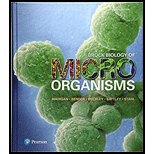
Brock Biology of Microbiology - Modern MasteringBiology
15th Edition
ISBN: 9780134602325
Author: MADIGAN
Publisher: PEARSON
expand_more
expand_more
format_list_bulleted
Question
Chapter 16.3, Problem 2MQ
Summary Introduction
Escherichia.coli is a Gram-negative, rod-shaped, facultative anaerobic bacteria. The species of Escherichia coli are inhabitants of the human intestinal tracts. It plays a nutritional role by generating vitamins, mainly vitamin K. Most of the strains of E.coli are harmless, while the others cause abdominal cramps, vomiting, fever, dehydration, bloody diarrhea, and even kidney failure. It is a mixed-acid fermenter.
Klebsiella is a Gram-negative, nonmotile, rod-shaped, oxidase-negative bacteria. It causes hospital-acquired urinary tract infections, pneumonia, septicemia, and soft tissue infections. It is a butanediol fermenter.
Expert Solution & Answer
Want to see the full answer?
Check out a sample textbook solution
Students have asked these similar questions
How does one can differentiate S. pneumoniae from E.coli
What part of the Escherichia coli cell contains endotoxin?
How does one can differentiate Klebsiella pneumoniae from Salmonella typhimurium
Chapter 16 Solutions
Brock Biology of Microbiology - Modern MasteringBiology
Ch. 16.1 - What are some ways in which Wolbachia species can...Ch. 16.1 - Prob. 2MQCh. 16.1 - Which genera of Alphaproteobacteria are known to...Ch. 16.2 - Prob. 1MQCh. 16.2 - Prob. 2MQCh. 16.2 - Prob. 1CRCh. 16.3 - Prob. 1MQCh. 16.3 - Prob. 2MQCh. 16.3 - What is the catalase test? What catalase reaction...Ch. 16.4 - What species of Pseudomonas is a common cause of...
Ch. 16.4 - What major characteristic could be used to...Ch. 16.4 - Prob. 1CRCh. 16.5 - What four metabolic traits are most common in...Ch. 16.5 - Why is Wolinella physiologically unusual among the...Ch. 16.5 - Prob. 1CRCh. 16.6 - Prob. 1MQCh. 16.6 - How can Streptococcus pyogenes be distinguished...Ch. 16.6 - What is the difference between homofermentative...Ch. 16.7 - Prob. 1MQCh. 16.7 - What characteristics differentiate Sarcina from...Ch. 16.7 - What characteristics of Listeria make it a...Ch. 16.8 - What is the major physiological distinction...Ch. 16.8 - What is the crystalline protein made by Bacillus...Ch. 16.8 - What is a good strategy for isolating...Ch. 16.9 - Prob. 1MQCh. 16.9 - Prob. 2MQCh. 16.9 - Prob. 1CRCh. 16.10 - What is snapping division and what organism...Ch. 16.10 - What organism is involved in the production of...Ch. 16.10 - Prob. 1CRCh. 16.11 - What is mycolic acid, and what properties does...Ch. 16.11 - Prob. 1CRCh. 16.12 - Prob. 1MQCh. 16.12 - Prob. 2MQCh. 16.12 - How are the spares of streptomycetes different...Ch. 16.13 - Prob. 1MQCh. 16.13 - What species of Bacteroidetes is most abundant in...Ch. 16.14 - Describe a method for isolating Cytophaga species...Ch. 16.14 - Prob. 2MQCh. 16.14 - Prob. 1CRCh. 16.15 - How are Chlamydia and Mycoplasma (Section 16.9)...Ch. 16.15 - Prob. 2MQCh. 16.15 - Prob. 1CRCh. 16.16 - Prob. 1MQCh. 16.16 - Prob. 2MQCh. 16.16 - What are two types of intracellular compartments...Ch. 16.17 - Prob. 1MQCh. 16.17 - Prob. 1CRCh. 16.18 - What is unique about the genome of Thermotoga and...Ch. 16.18 - Prob. 1CRCh. 16.19 - Prob. 1MQCh. 16.19 - Prob. 1CRCh. 16.20 - Describe a commercial application of Thermus...Ch. 16.20 - Describe an unusual biological feature of...Ch. 16.20 - What are some of the remarkable properties that...Ch. 16.21 - Prob. 1MQCh. 16.21 - Prob. 2MQCh. 16.21 - Prob. 3MQCh. 16.21 - Prob. 1CRCh. 16 - Enteric bacteria, lactic acid bacteria, and...Ch. 16 - Microorganisms can have a variety of different...
Knowledge Booster
Learn more about
Need a deep-dive on the concept behind this application? Look no further. Learn more about this topic, biology and related others by exploring similar questions and additional content below.Similar questions
- Name four different pathogenic groups of Escherichia coli.arrow_forwardWhat Enterobacteriaceae are of medical significance?List and describe the infections caused by these organisms.arrow_forwardWhat are the cardinal temperatures for Escherichia coli? Towhat temperature class does it belong?arrow_forward
- What bacterial genus is commonly found in the intestines of birds and reptiles? A) Neisseria B) Salmonella C) Rickettsia D) Bacillus E) Treponemaarrow_forwardWhich coliform bacteria are the most difficult to distinguish from the Salmonella or Shigella pathogens? What is the primary characteristic used to differentiate them?arrow_forwardCharacterize and give a brief description of the following bacteria: Salmonella enteritis Yersina Pestisarrow_forward
- Define and sketch the following: A) bacillus B) coccus C) strepto D) staphylo What is the differance between "Bacillus and bacillus"?arrow_forwardUsing a microscope, how could you distinguish the cocci that cause staph infections from those that cause strep throat?arrow_forwardWrite a brief description of Escherichia coli, Yersinia Pestis, Yersinia enterocoliticaarrow_forward
arrow_back_ios
SEE MORE QUESTIONS
arrow_forward_ios
Recommended textbooks for you

Bacterial Endospore Formation -Biology Pundit; Author: Biology Pundit;https://www.youtube.com/watch?v=6_sinRhE8zA;License: Standard YouTube License, CC-BY